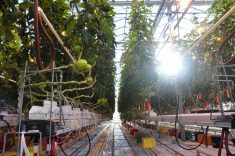A Saskatchewan company developing a project to generate electricity from geothermal heat has struck a deal with a British Columbia-based firm to build a greenhouse to take advantage of the heat.
There is expanding interest in using geothermal heat to make green electricity, and by adding greenhouses to the projects, there is potential to lessen our reliance on produce imported from the United States and even more distant countries.
DEEP Earth Energy Production Corp. is well on its way to developing Canada’s first geothermal powered electricity power plant in southeastern Saskatchewan.
Read Also

Russian wheat exports start to pick up the pace
Russia has had a slow start for its 2025-26 wheat export program, but the pace is starting to pick up and that is a bearish factor for prices.
The company has drilled 3.5 kilometre deep wells to access the natural heat in brine reservoirs. The hot water will be brought to the surface to power an organic Rankine cycle engine to generate electricity.
The remaining heat could find additional uses, such as warming a greenhouse, before the brine is pumped back underground to warm again
DEEP is planning and developing the financing for a pilot plant to generate five megawatts of almost carbon-free, green, base load electricity, available 24 hours a day, 365 days a year.
If that proves successful, it would develop several larger projects of 25 to 50 MW, potentially leading to a total of 180 MW of green power.
From the beginning, DEEP has talked about potential spinoffs, using the heat to supply greenhouses, fish farms, food processing and other industrial applications.
In July 2021 I mentioned DEEP’s project in a column about the opportunities in the booming global aquaculture sector.
But a greenhouse will be the first spinoff.
In April, the company announced a partnership with Oppy, a leading grower, marketer and distributor of fresh produce, to establish a greenhouse.
Oppy’s roots go back to 1858 when Charles Oppenheimer travelled north from California to Victoria, a pioneer supply point for B.C.’s Fraser River gold rush.
As is often the case, the people with the most success from a gold rush are not miners but those who supply miners.
Oppenheimer opened a store and followed up its success, along with his brothers, by opening more stores in the following decades, supplying miners in the Cariboo and Klondike gold rushes and the growing population of the new province.
One of the brothers, David, became Vancouver’s second mayor.
To supply their growing business, the Oppenheimers formed partnerships with fruit and produce producers in B.C. and later in the U.S. and Mexico. The company also partnered with growers overseas, especially New Zealand, to import apples and other produce.
It formed a transportation company to ship the produce to end users.
It has a keen interest in fair trade and sustainability and has been recognized for 17 years as one of Canada’s best managed companies under the Deloitte business awards program.
The news release announcing the partnership is unfortunately short on details, and it will likely be several years before a greenhouse is operating, but the plan is innovative and important.
Health experts say Canadians need more vegetables and fruit in their diet, but fresh produce is often among the most expensive foods in the grocery store.
The expense includes what it costs to transport the produce from the U.S., Mexico and elsewhere and the risk of currency fluctuation. When the Canadian dollar weakens, it becomes more expensive to import things from the U.S.
Also, produce costs fluctuate with the weather, and a drought or freeze can cause the price to soar.
If Canada was able to build up its greenhouse industry, it would cut transportation costs and reduce risks from weather and currency fluctuations. And if it expands using green energy, so much the better.
Other geothermal projects are being investigated in the Municipal District of Greenview near Grand Prairie, Alta., and the Clarke Lake area near Fort Nelson, B.C.
A Calgary geothermal company, Eavor Technologies, is also gaining a reputation with a technology different from DEEP Earth, but which also captures geothermal heat to make electricity.
As these technologies are refined, more projects are likely to come forward.
And in coming decades there might be greater leaps in technology.
Quaise Energy, a company spun out from research at the Massachusetts Institute of Technology, has a plan to unlock vast amounts of energy with a radical new approach to ultra-deep drilling.
Its technology would use powerful microwave drilling to vaporize rock and rapidly get to a depth of 20 km or deeper to access temperatures of 500 C. One idea is to drill such wells next to existing coal-fired power plants and use the geothermal steam to power the turbines instead of burning coal.















